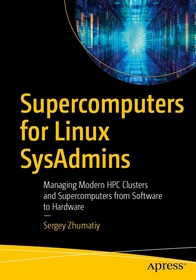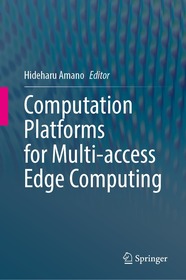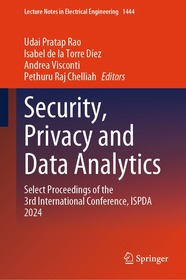
Supercomputers for Linux SysAdmins
Managing Modern HPC Clusters and Supercomputers from Software to Hardware
-
12% KEDVEZMÉNY?
- A kedvezmény csak az 'Értesítés a kedvenc témákról' hírlevelünk címzettjeinek rendeléseire érvényes.
- Kiadói listaár EUR 53.49
-
22 184 Ft (21 128 Ft + 5% áfa)
Az ár azért becsült, mert a rendelés pillanatában nem lehet pontosan tudni, hogy a beérkezéskor milyen lesz a forint árfolyama az adott termék eredeti devizájához képest. Ha a forint romlana, kissé többet, ha javulna, kissé kevesebbet kell majd fizetnie.
- Kedvezmény(ek) 12% (cc. 2 662 Ft off)
- Kedvezményes ár 19 522 Ft (18 593 Ft + 5% áfa)
Iratkozzon fel most és részesüljön kedvezőbb árainkból!
Feliratkozom
22 184 Ft

Beszerezhetőség
Még nem jelent meg, de rendelhető. A megjelenéstől számított néhány héten belül megérkezik.
Why don't you give exact delivery time?
A beszerzés időigényét az eddigi tapasztalatokra alapozva adjuk meg. Azért becsült, mert a terméket külföldről hozzuk be, így a kiadó kiszolgálásának pillanatnyi gyorsaságától is függ. A megadottnál gyorsabb és lassabb szállítás is elképzelhető, de mindent megteszünk, hogy Ön a lehető leghamarabb jusson hozzá a termékhez.
A termék adatai:
- Kiadás sorszáma First Edition
- Kiadó Apress
- Megjelenés dátuma 2025. október 24.
- Kötetek száma 1 pieces, Book
- ISBN 9798868815997
- Kötéstípus Puhakötés
- Terjedelem470 oldal
- Méret 254x178 mm
- Nyelv angol
- Illusztrációk XXV, 470 p. 18 illus. 700
Kategóriák
Hosszú leírás:
"
Supercomputers and High Performance Computing (HPC) clusters are not so exotic as people imagine these days. They give companies the power of computation like no one server can give alone. They make new drugs and materials discoveries, universe modeling and AI training, crash simulations and market research possible – all thanks to HPC clusters. Building or renting a HPC cluster is not so difficult either as cloud providers can give you resources to build one cheap and performative enough to use yourself, so If you are or want to become HPC cluster Sysadmin or manager, this book is for you.
Supercomputers for Linux SysAdmins delves into the world of modern HPC cluster architecture, hardware, software and resources management using a Linux/UNIX based approach. The number of HPC clusters is growing with an estimated 30 billion by 2030 but there are not enough sysadmins to run and manage them, this book serves to bridge this gap to help more Sysadmins and managers to transition into the exiting world of HPCs.
This book helps those with a strong foundational knowledge in Linux, to deal with supercomputers and HPC clusters. We start with the basic principles of supercomputer management, fundamentals of Linux and UNIX, Shell Scripting and systemd and well as other open source tools and frameworks, taking you thorough the security, monitoring and hardware requirements for supercomputers and HPC clusters.
You Will Learn:
- How to plan new supercomputers
- The main principles and technologies used in supercomputers and HPC clusters
- How to set up the software environments on new supercomputers
- To set up supercomputer and HPC cluster resources and jobs management
- To manage accounts, resource sharing and many more.
Who is it for:
The main audience of this book are regular UNIX/Linux sysadmins and managers, who should deal with HPC clusters on-prem or in cloud and those who are interested in supercomputers and HPC clusters and how to utilize them in their projects and teams.
" TöbbTartalomjegyzék:
"
1: Introduction.- 2: What is ""super""?.- 3: How to build and start it?.- 4: Supercomputer Hardware.- Chapter 5: InfiniBand.- 6: How a supercomputer does the job.- 7: UNIX and Linux – the basics.- 8: UNIX and Linux – working techniques.- Chapter 9: Network File Systems.- Chapter 10: Remote Management.- 11: Users – Accounting, Management.- 12: Users – quotas, access rights.- 13: Job management systems.- 14: OpenPBS, Torque.- 15: Slurm.- 16: Containers.- 17: Clouds.- 18: Remote User Access.- 19: Cluster Status Monitoring Systems.- 20: Backup.- 21: Compilers and Environments, for Parallel Technologies.- 22: Parallel Computing Support Libraries.- 23. Booting and init.- 24: Node Setup, Software Installation.- 25: Out-of-the-box stacks and deployment systems.- 26: Cluster Management Systems – xCAT and others.- 27: Communicating with users.- 28: One-two-three instructions.- 29: Shell scripts – basics and common mistakes.- 30: Systemd – A Short Course.- 31. Conclusion.- Glossary.
" Több








